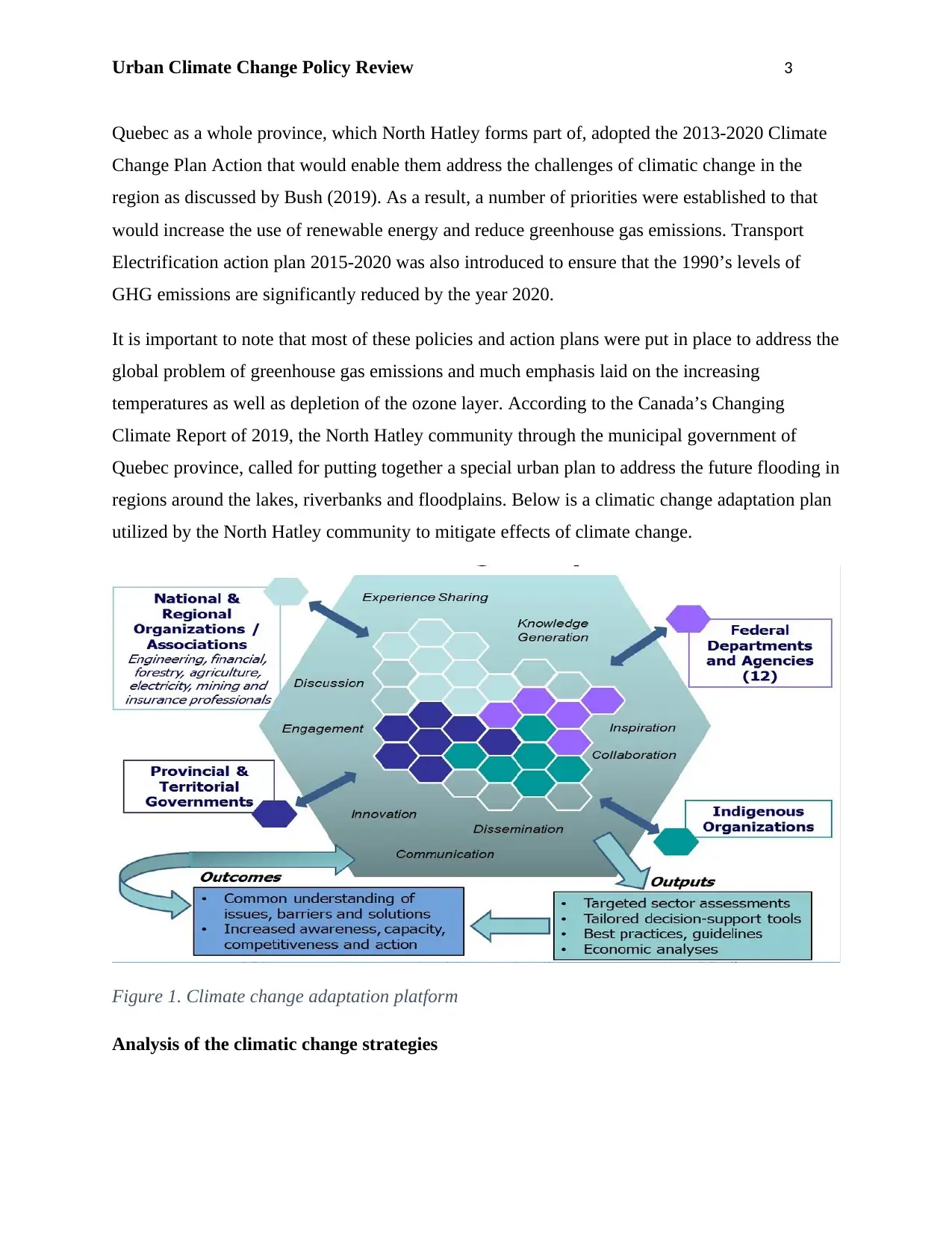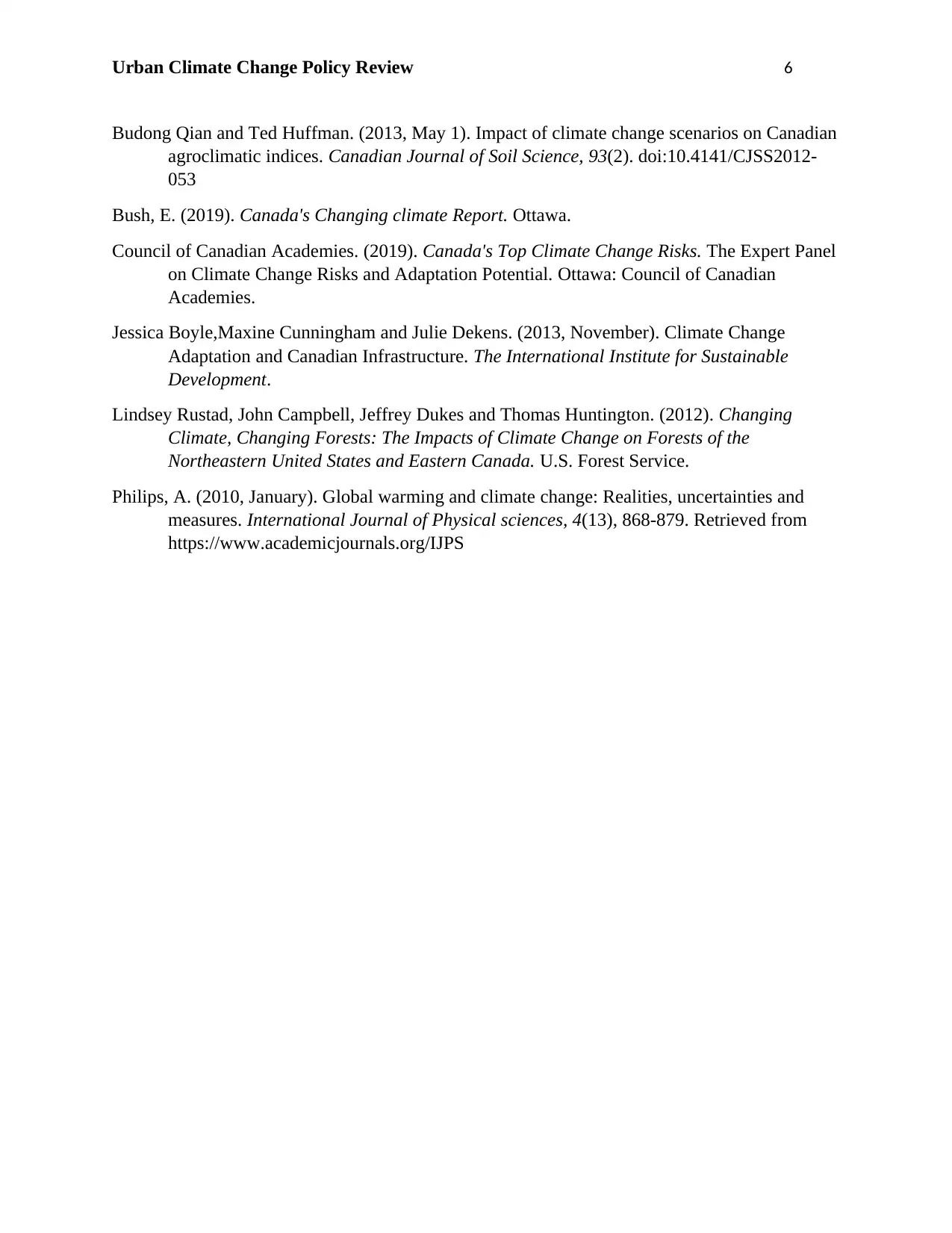Urban Climate Change Policy Review: Strategies in North Hatley, Canada
VerifiedAdded on 2022/08/12
|6
|1358
|27
Report
AI Summary
This report provides an in-depth review of the urban climate change policies implemented by the North Hatley community in Quebec, Canada. It examines the local government's strategies to mitigate the effects of climate change, focusing on plans such as transitioning to renewable energy sources, improving energy efficiency, and enhancing public transportation. The analysis includes an evaluation of the strengths and weaknesses of these strategies, considering their alignment with broader climate change initiatives and their potential for long-term success. The report also highlights the community's approach to urban planning, particularly in relation to flood management, and identifies areas where further structural measures could be implemented. The report emphasizes the need for a comprehensive and coordinated approach to climate change, including collaboration with other communities and a focus on both policy and structural solutions to ensure the effectiveness of the implemented plans.

Running head: Urban Climate Change Policy Review
1
Geography
Urban Climate Change Policy Review
1
Geography
Urban Climate Change Policy Review
Paraphrase This Document
Need a fresh take? Get an instant paraphrase of this document with our AI Paraphraser

Urban Climate Change Policy Review 2
Introduction
A simple definition given to climate change by the Council of Canadian Academies (2019) is
that it refers to the long-term effects caused by human activities such as emission of greenhouse
gases, resulting into increased temperatures leading to a shift in weather patterns. The effects
include devastating weather phenomena like tornadoes, hurricanes, cyclones, depletion of ozone
layer and melting of glacier causing a rise in the sea level.
In order to mitigate these catastrophic effects of climate change, there is urgent need to come up
with policies and action plans to address the effects and put in place recovery mechanisms
Jessica B. et al. (2013). This paper therefore gives an in-depth analysis of climatic change
strategies put in place by the North Hatley community in Quebec province of Canada, to mitigate
the effects of climate change.
Summary of plans
North Hatley is a small community located in southern Quebec, with a total population of 632
people according to the 2016 census and occupies a geographical area of 4.60 km2, with an
elevation of 167m.
The local authorities have come up with a number of local climatic mitigation and adaptation
plans through official publications in an attempt to lessen the effect of global warming. These
include but not limited to:
Substituting the use of fossil fuel with other clean forms of energy like wing and solar
energy. This also includes improving energy efficiency of buildings as well as industrial
processes.
Integrate transport lines and create efficiencies by use of bigger buses to enable mass
transportation as opposed to using of many private individual cars.
Incorporation of renewable energy in all sectors of production.
Introduction of Bill 102, Bill 104 and Bill 106
The 2030 Energy policy
Urban planning to eliminate structures in flood plains by a detailed cartographic flood
plain exercise. This gives an understanding of high velocity flood plains and low velocity
flood plains as suggested by news from the council in July 2017.
Introduction
A simple definition given to climate change by the Council of Canadian Academies (2019) is
that it refers to the long-term effects caused by human activities such as emission of greenhouse
gases, resulting into increased temperatures leading to a shift in weather patterns. The effects
include devastating weather phenomena like tornadoes, hurricanes, cyclones, depletion of ozone
layer and melting of glacier causing a rise in the sea level.
In order to mitigate these catastrophic effects of climate change, there is urgent need to come up
with policies and action plans to address the effects and put in place recovery mechanisms
Jessica B. et al. (2013). This paper therefore gives an in-depth analysis of climatic change
strategies put in place by the North Hatley community in Quebec province of Canada, to mitigate
the effects of climate change.
Summary of plans
North Hatley is a small community located in southern Quebec, with a total population of 632
people according to the 2016 census and occupies a geographical area of 4.60 km2, with an
elevation of 167m.
The local authorities have come up with a number of local climatic mitigation and adaptation
plans through official publications in an attempt to lessen the effect of global warming. These
include but not limited to:
Substituting the use of fossil fuel with other clean forms of energy like wing and solar
energy. This also includes improving energy efficiency of buildings as well as industrial
processes.
Integrate transport lines and create efficiencies by use of bigger buses to enable mass
transportation as opposed to using of many private individual cars.
Incorporation of renewable energy in all sectors of production.
Introduction of Bill 102, Bill 104 and Bill 106
The 2030 Energy policy
Urban planning to eliminate structures in flood plains by a detailed cartographic flood
plain exercise. This gives an understanding of high velocity flood plains and low velocity
flood plains as suggested by news from the council in July 2017.

Urban Climate Change Policy Review 3
Quebec as a whole province, which North Hatley forms part of, adopted the 2013-2020 Climate
Change Plan Action that would enable them address the challenges of climatic change in the
region as discussed by Bush (2019). As a result, a number of priorities were established to that
would increase the use of renewable energy and reduce greenhouse gas emissions. Transport
Electrification action plan 2015-2020 was also introduced to ensure that the 1990’s levels of
GHG emissions are significantly reduced by the year 2020.
It is important to note that most of these policies and action plans were put in place to address the
global problem of greenhouse gas emissions and much emphasis laid on the increasing
temperatures as well as depletion of the ozone layer. According to the Canada’s Changing
Climate Report of 2019, the North Hatley community through the municipal government of
Quebec province, called for putting together a special urban plan to address the future flooding in
regions around the lakes, riverbanks and floodplains. Below is a climatic change adaptation plan
utilized by the North Hatley community to mitigate effects of climate change.
Figure 1. Climate change adaptation platform
Analysis of the climatic change strategies
Quebec as a whole province, which North Hatley forms part of, adopted the 2013-2020 Climate
Change Plan Action that would enable them address the challenges of climatic change in the
region as discussed by Bush (2019). As a result, a number of priorities were established to that
would increase the use of renewable energy and reduce greenhouse gas emissions. Transport
Electrification action plan 2015-2020 was also introduced to ensure that the 1990’s levels of
GHG emissions are significantly reduced by the year 2020.
It is important to note that most of these policies and action plans were put in place to address the
global problem of greenhouse gas emissions and much emphasis laid on the increasing
temperatures as well as depletion of the ozone layer. According to the Canada’s Changing
Climate Report of 2019, the North Hatley community through the municipal government of
Quebec province, called for putting together a special urban plan to address the future flooding in
regions around the lakes, riverbanks and floodplains. Below is a climatic change adaptation plan
utilized by the North Hatley community to mitigate effects of climate change.
Figure 1. Climate change adaptation platform
Analysis of the climatic change strategies
⊘ This is a preview!⊘
Do you want full access?
Subscribe today to unlock all pages.

Trusted by 1+ million students worldwide

Urban Climate Change Policy Review 4
The community’s attempt to address the pressing issue of GHG emissions is commendable and is
a long-term action plan to reduce effects of climate change. Since this is a scientific concept
based on forecasting, application of computer models to determine the levels of reduction in the
carbon footprint is necessary (Philips, 2010). The challenge is that with the increasing demand of
energy as population rises, the policies does not address the future expansion of renewable
energy convincingly to enable residents shift from fossil fuel to clean energy. It is also not
clearly detailed on how the public transport system will be managed and other restrictions on
private vehicle ownership to encourage mass transportation using buses. This part needs clarity
for the successful implementation of the action plan proposed by the North Hatley community
through various local government policy publications.
One of the major strengths of these strategies is that they are in conformity with those of the
OECD, UNEP and other organizations dealing with climate change. This means that they can
easily facilitate the goals of this small community in achieving their strategic plans form
mitigation of climate change, making it successful in the long-run.
The action plans proposed by the community are comprehensive and involves relevant
stakeholders in transport sector, industrial sectors and even government agencies, a perspective
shared by Budong Q & Ted H. (2013).
Both the electrification action plan 2015-2020 and the 2013-2020 Climate Change Plan Action
can be successfully implemented to reduce combustion of fossil fuel. However, the document
does not give the intermediate achievements of the laid down plans. Successive reports should be
provided at given timelines so as to assess the possibility of achieving the overall goal, through
the measurement of small progressive changes. This would make it easier to adjust areas seen to
be lagging behind (Lindsey et al., 2012).
As much as the North Hatley community worked hard in contributing towards the reduction of
global warming effects, most of them involves policies but not much of structural measures. For
instance, the flooding event in April and May 2017 can be prevented from occurring in future by
creating of dykes and levees on the flood plains. Therefore, emphasis should also be laid on the
structural measure and not just policies alone.
Conclusion
The community’s attempt to address the pressing issue of GHG emissions is commendable and is
a long-term action plan to reduce effects of climate change. Since this is a scientific concept
based on forecasting, application of computer models to determine the levels of reduction in the
carbon footprint is necessary (Philips, 2010). The challenge is that with the increasing demand of
energy as population rises, the policies does not address the future expansion of renewable
energy convincingly to enable residents shift from fossil fuel to clean energy. It is also not
clearly detailed on how the public transport system will be managed and other restrictions on
private vehicle ownership to encourage mass transportation using buses. This part needs clarity
for the successful implementation of the action plan proposed by the North Hatley community
through various local government policy publications.
One of the major strengths of these strategies is that they are in conformity with those of the
OECD, UNEP and other organizations dealing with climate change. This means that they can
easily facilitate the goals of this small community in achieving their strategic plans form
mitigation of climate change, making it successful in the long-run.
The action plans proposed by the community are comprehensive and involves relevant
stakeholders in transport sector, industrial sectors and even government agencies, a perspective
shared by Budong Q & Ted H. (2013).
Both the electrification action plan 2015-2020 and the 2013-2020 Climate Change Plan Action
can be successfully implemented to reduce combustion of fossil fuel. However, the document
does not give the intermediate achievements of the laid down plans. Successive reports should be
provided at given timelines so as to assess the possibility of achieving the overall goal, through
the measurement of small progressive changes. This would make it easier to adjust areas seen to
be lagging behind (Lindsey et al., 2012).
As much as the North Hatley community worked hard in contributing towards the reduction of
global warming effects, most of them involves policies but not much of structural measures. For
instance, the flooding event in April and May 2017 can be prevented from occurring in future by
creating of dykes and levees on the flood plains. Therefore, emphasis should also be laid on the
structural measure and not just policies alone.
Conclusion
Paraphrase This Document
Need a fresh take? Get an instant paraphrase of this document with our AI Paraphraser

Urban Climate Change Policy Review 5
From the foregoing, it is evident that the North Hatley community is committed in managing the
challenges caused by climate change. A number of strategies are highlighted which may prove
effective when implemented properly to reduce transmission of EGH, as well as other measures
that increases efficiencies by use of renewable energy. One of the key findings in these action
plans that may not make them see the light of the day is that the community is not working in
hand with other communities in the Quebec province to create regional strength for pushing
forward the agenda of climate change. In a nutshell, the community’s policies are likely to
succeed because they are well thought of and brought forward to the local government. In my
opinion however, I feel that more structural measures need to be considered for a more
successful approach in the climate change menace.
Bibliography
From the foregoing, it is evident that the North Hatley community is committed in managing the
challenges caused by climate change. A number of strategies are highlighted which may prove
effective when implemented properly to reduce transmission of EGH, as well as other measures
that increases efficiencies by use of renewable energy. One of the key findings in these action
plans that may not make them see the light of the day is that the community is not working in
hand with other communities in the Quebec province to create regional strength for pushing
forward the agenda of climate change. In a nutshell, the community’s policies are likely to
succeed because they are well thought of and brought forward to the local government. In my
opinion however, I feel that more structural measures need to be considered for a more
successful approach in the climate change menace.
Bibliography

Urban Climate Change Policy Review 6
Budong Qian and Ted Huffman. (2013, May 1). Impact of climate change scenarios on Canadian
agroclimatic indices. Canadian Journal of Soil Science, 93(2). doi:10.4141/CJSS2012-
053
Bush, E. (2019). Canada's Changing climate Report. Ottawa.
Council of Canadian Academies. (2019). Canada's Top Climate Change Risks. The Expert Panel
on Climate Change Risks and Adaptation Potential. Ottawa: Council of Canadian
Academies.
Jessica Boyle,Maxine Cunningham and Julie Dekens. (2013, November). Climate Change
Adaptation and Canadian Infrastructure. The International Institute for Sustainable
Development.
Lindsey Rustad, John Campbell, Jeffrey Dukes and Thomas Huntington. (2012). Changing
Climate, Changing Forests: The Impacts of Climate Change on Forests of the
Northeastern United States and Eastern Canada. U.S. Forest Service.
Philips, A. (2010, January). Global warming and climate change: Realities, uncertainties and
measures. International Journal of Physical sciences, 4(13), 868-879. Retrieved from
https://www.academicjournals.org/IJPS
Budong Qian and Ted Huffman. (2013, May 1). Impact of climate change scenarios on Canadian
agroclimatic indices. Canadian Journal of Soil Science, 93(2). doi:10.4141/CJSS2012-
053
Bush, E. (2019). Canada's Changing climate Report. Ottawa.
Council of Canadian Academies. (2019). Canada's Top Climate Change Risks. The Expert Panel
on Climate Change Risks and Adaptation Potential. Ottawa: Council of Canadian
Academies.
Jessica Boyle,Maxine Cunningham and Julie Dekens. (2013, November). Climate Change
Adaptation and Canadian Infrastructure. The International Institute for Sustainable
Development.
Lindsey Rustad, John Campbell, Jeffrey Dukes and Thomas Huntington. (2012). Changing
Climate, Changing Forests: The Impacts of Climate Change on Forests of the
Northeastern United States and Eastern Canada. U.S. Forest Service.
Philips, A. (2010, January). Global warming and climate change: Realities, uncertainties and
measures. International Journal of Physical sciences, 4(13), 868-879. Retrieved from
https://www.academicjournals.org/IJPS
⊘ This is a preview!⊘
Do you want full access?
Subscribe today to unlock all pages.

Trusted by 1+ million students worldwide
1 out of 6
Related Documents
Your All-in-One AI-Powered Toolkit for Academic Success.
+13062052269
info@desklib.com
Available 24*7 on WhatsApp / Email
![[object Object]](/_next/static/media/star-bottom.7253800d.svg)
Unlock your academic potential
Copyright © 2020–2025 A2Z Services. All Rights Reserved. Developed and managed by ZUCOL.





